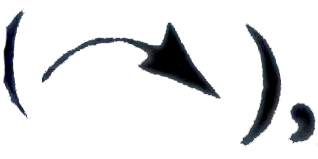Heterolysis of bonds to carbon does not lead to the formation of
A
carbocations
B
carbanions
C
free radicals
D
both (1) and (2)
Video Solution
Text Solution
The correct Answer is:C
In hetrolytic cleavage, the bonding electron pair between the two bonded atoms in the molecule A−B is shifted to either of the atoms giving charged species as intermediates:

This is shift of bonding electron pair is shown by a curved arrow  , which starts from the middel of the bond that breaks and ends on the atom to which the electron pair shifts. When a positive charge is carried on carbon, the entity is known as a cabocation, and when a negative charge is carried, the entity is known as carbonion.
, which starts from the middel of the bond that breaks and ends on the atom to which the electron pair shifts. When a positive charge is carried on carbon, the entity is known as a cabocation, and when a negative charge is carried, the entity is known as carbonion.
|
Topper's Solved these Questions
- GENERAL ORGANIC CHEMISTRYBook:R SHARMAChapter:GENERAL ORGANIC CHEMISTRYExercise:Follow up test 2
Explore 8 Videos
- GENERAL ORGANIC CHEMISTRYBook:R SHARMAChapter:GENERAL ORGANIC CHEMISTRYExercise:Follow-up test 3
Explore 9 Videos
- GENERAL ORGANIC CHEMISTRYBook:R SHARMAChapter:GENERAL ORGANIC CHEMISTRYExercise:Archives
Explore 36 Videos
- EQUILIBRIUMBook:R SHARMAChapter:EQUILIBRIUMExercise:ARCHIVES
Explore 69 Videos
- ISOMERISMBook:R SHARMAChapter:ISOMERISMExercise:Archives
Explore 11 Videos
Similar Questions
Knowledge Check
What kind of radioactive decay does not lead to the formation of a daughter nucleus that is an isobar of the parent nucleus
Aα−raysBβ−raysCPositronDElectron captureHeterolysis of C-Br bond produces
Atwo carbanionsBtwo carbocationsCtwo free radicalsDone cation and one anionCarbonate ore of lead is
ACasseteriteBGalenaCAnglesiteDCerrusite
Does geographical isolation of individuals of a species lead to the formation of a new species ? Provide a suitable explanation for your answer.
View SolutionReaction of with RMgX leads to formation of

View SolutionWhich of the following reactions does not lead to formation of an alkanol ?
View SolutionWhich allotrope of carbon leads to the formation of bucky ball ?
View SolutionHomolysis of propane gives:
View Solution


 with
with